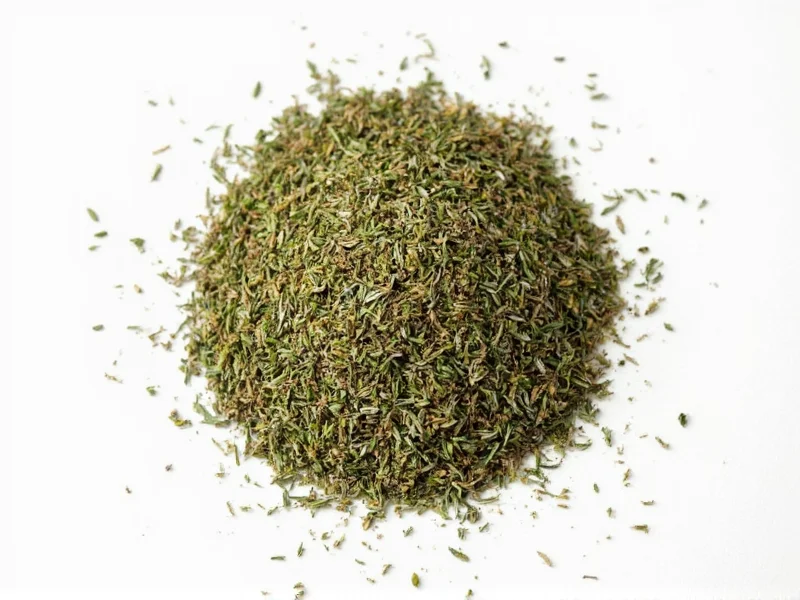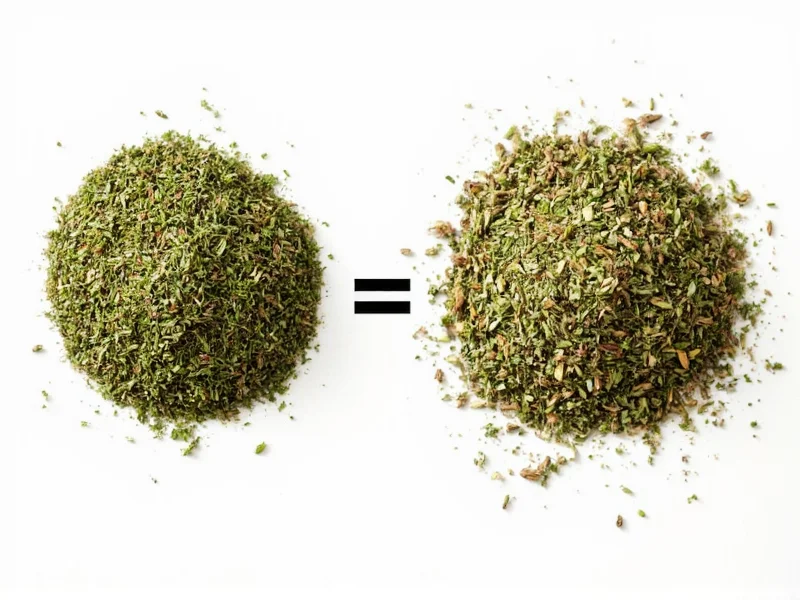Why Herb Form Matters in Your Cooking
Ever ruined a dish because your thyme substitution didn't work? You're not alone. Many home cooks struggle with herb conversions, adding too much ground thyme thinking it's weaker than dried, or using dried thyme in quick sauces where it never properly rehydrates. Understanding the subtle but critical differences between ground and dried thyme prevents flavor disasters and helps you maximize this versatile herb's potential.
Ground Thyme vs. Dried Thyme: Key Differences
While both forms originate from the same herb, their physical structure creates distinct culinary properties. Ground thyme isn't a different product—it's dried thyme that's been processed to a fine powder. This simple transformation significantly impacts how it behaves in cooking.
| Characteristic | Ground Thyme | Dried Thyme (Whole) |
|---|---|---|
| Physical Form | Fine powder | Whole leaves/stems |
| Flavor Release | Immediate (high surface area) | Gradual (requires rehydration) |
| Best Added | Late in cooking or at finish | Early or midway through cooking |
| Texture Impact | Smooth integration | Potentially gritty if not cooked sufficiently |
| Shelf Life | 6-12 months (faster flavor loss) | 1-4 years (longer stability) |
| Nutritional Value* | Identical per volume | Identical per volume |
*Per NutritionDataHub, dried thyme contains 276 kcal, 9.11g protein, 63.90g carbs, and 7.43g fat per 100g, with exceptional vitamin K (1710µg, 1425% DV) and iron (124mg, 689% DV) content.

When to Choose Ground Thyme
Ground thyme shines in applications where quick flavor integration matters:
- Rub applications: Blends seamlessly into spice rubs without leaving leaf fragments
- Dry marinades: Creates uniform coating on proteins
- Quick sauces: Integrates fully in pan sauces or gravies with short cooking times
- Baking applications: Distributes evenly in breads and savory pastries
- Dressings and dips: Creates smooth texture without leaf bits
As Christopher Kimball's Milk Street notes, "Dried herbs must rehydrate to unlock their flavor and soften their texture." Ground thyme bypasses this need through its increased surface area.
When Dried Thyme Works Better
Whole dried thyme maintains structural integrity for specific culinary applications:
- Long-simmered dishes: Soups, stews, and braises where gradual flavor release is desirable
- Infused oils and vinegars: Whole leaves create cleaner infusions
- Herb sachets: Can be contained in cheesecloth for easy removal
- Visual presentation: Provides texture contrast in finished dishes
- Extended storage needs: Maintains potency longer than ground form
According to Savory Spice Shop, "Dried thyme is more earthy due to its dehydrated consistency," making it ideal for dishes where deep, mellow herbal notes are desired.
Precision Measurement Guide
The substitution ratio between ground and dried thyme is 1:1 by volume. However, proper measurement technique matters:
- For dried thyme: Lightly crush leaves between fingers before measuring to release oils
- For ground thyme: Spoon gently into measuring spoon—don't pack
- When substituting: Start with ¾ teaspoon ground thyme for every 1 teaspoon dried thyme, then adjust to taste

Avoiding Common Quality Issues
Not all thyme products deliver equal quality. Research from PMC shows concerning contamination levels in some products:
- 86% of tested thyme samples exceeded safe lead limits
- 22% had unacceptable mercury levels
- 11% showed problematic arsenic contamination
Choose products that:
- Display "non-irradiated" labeling (per Juniper Berry Wholesaler)
- Come in opaque, airtight containers
- List origin information (quality varies by growing region)
- Have vibrant green color (dull gray indicates age)
- Show no signs of moisture or clumping
Storage Best Practices
Maximize shelf life with these storage techniques:
- Store in airtight glass containers away from heat and light
- Keep ground thyme separate from dried thyme (ground degrades faster)
- Label containers with purchase date
- Replace ground thyme after 12 months; dried thyme after 24 months
- Never store above the stove or near dishwasher (heat and moisture destroy potency)
As noted by Milk Street, "Dried herbs have a lifespan. As with spices, their flavor fades and we recommend purchasing smaller amounts you'll use up within the year."
Three Critical Substitution Mistakes to Avoid
Mistake #1: Treating Them as Interchangeable in All Recipes
Ground thyme integrates too quickly in long-cooked dishes, resulting in bitter, one-dimensional flavor. Use dried thyme for anything simmering longer than 30 minutes.
Mistake #2: Measuring Ground Thyme Like Salt
Unlike salt, ground thyme shouldn't be packed into measuring spoons. Spoon it lightly to avoid overdosing—thyme's potency concentrates when ground.
Mistake #3: Adding Dried Thyme Too Late
Dried thyme needs time to rehydrate. Add it at the beginning of cooking for sauces or midway through for soups. As Urban Leaf explains, "Dried mint is essential to Levantine and Greek cooking and packs a surprisingly potent flavor" when given time to infuse.
Everything You Need to Know
Ground thyme isn't inherently stronger but releases flavor more quickly due to increased surface area. When substituting, start with ¾ teaspoon ground thyme for every 1 teaspoon dried thyme, then adjust to taste. The nutritional profile remains identical per volume, but the immediate flavor release can make ground thyme seem more potent in quick-cooking applications.
Not in all recipes. Ground thyme works well in quick sauces, rubs, and baked goods where immediate flavor integration is needed. Avoid substituting in long-simmered dishes (over 30 minutes) as ground thyme can become bitter. For soups and stews, use dried thyme added at the beginning of cooking to allow proper rehydration and gradual flavor release.
Check for three signs: 1) Color change from vibrant green to dull brown/gray, 2) Loss of strong aroma (rub between fingers—if barely scented, it's expired), 3) Musty or dusty smell instead of earthy-peppery fragrance. Properly stored dried thyme lasts 1-4 years, but ground thyme loses potency faster (6-12 months). As Milk Street recommends, "purchase smaller amounts you'll use up within the year" for optimal flavor.
Yes, and it's often superior. Freshly ground thyme from high-quality dried leaves delivers more vibrant flavor than pre-ground commercial products. Use a dedicated spice grinder or mortar and pestle for best results. As noted by Milk Street, "particularly tough or twiggy dried herbs that may be unpleasant to eat can be pulverized in a mortar and pestle or spice grinder to a fine texture that will disappear into a soup or stew."
Thyme is generally safe in culinary amounts. However, research shows thyme contains thymol, which has therapeutic benefits but can cause issues in medicinal doses. Culinary use (1-2 teaspoons per dish) poses no risk for most people. Those on blood thinners should monitor intake due to thyme's high vitamin K content (1710µg per 100g, 1425% DV). Also check for heavy metal contamination—86% of tested samples exceeded safe lead limits.










 浙公网安备
33010002000092号
浙公网安备
33010002000092号 浙B2-20120091-4
浙B2-20120091-4